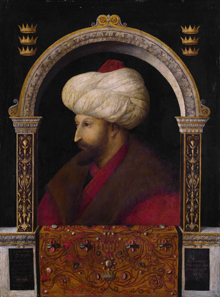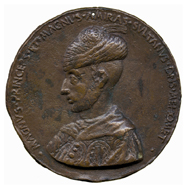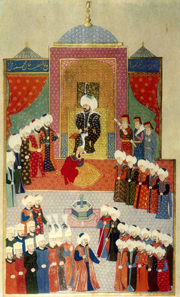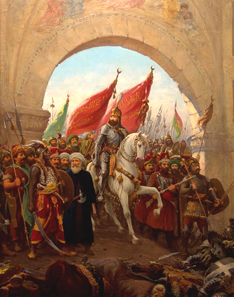February 23, 2012 – On the 25th April Baldwin’s will offer for sale one of the most important pieces of Islamic historical documentation. The discovery of the Magnus Princeps Bronze Portrait Medal of Sultan Mehmed II, c. 1460 in late 2000 provides the earliest known portrait of one of history’s greatest military commanders.
Portrait of Sultan Mehmed II attributed to Gentile Bellini, 1480. National Gallery London. Source: Wikipedia.
Prior to this the only reliable appearance of the most famous Sultan of the Ottoman Empire’s rested on two portraits produced towards the end of his life: one on a medal executed by Constanzo da Ferrara in the mid-to late 1470s, which shows the Sultan as corpulent, wizened and well into middle age; the other on a painting by Gentile Bellini, the elderly and now frail image of the Sultan having been taken shortly before his death. Mehmed II had done much to bring European artists and craftsmen to the Ottoman Court, and these universally known portraits are the result of independent visits that the two Italian artists made to Constantinople in the latter part of the Sultan’s life. The Sultan’s physical appearance from this early period has been one of the imponderables of Ottoman scholarship, for which no evidence was thought to have survived.
The script on the top of the medal reads MAGNVS PRINCEPS ET MAGNVS AMIRAS SULTANVS DNS MEHOMET [Great Prince and Great Amir, Sultan Lord Mehmed]; a fitting tribute to the man who, aged just twenty-one, masterminded the siege of Byzantium (bringing an end to the Byzantine Empire) and established the foundation of Constantinople (renamed Istanbul during the Ottoman reign) as the capital city of the Ottoman Empire. Made in the decade following the siege and capture of Constantinople in 1453, the medal is a significant piece of Ottoman iconography from this early period of Mehmed’s sultanate and, as the only know example, is of the greatest rarity.
Accession of Mehmed II in Edirne 1451, 1584. Topkapi Palace Museum, Hazine 1523, Hüner-name. Source: Wikipedia.
After a very brief reign from the age of twelve (1444-1446), Mehmed II ascended the throne for a second time in 1451. His ambition was to create a world empire like the Roman Empire and his first move towards this came with the incorporation of the old Byzantine administration into the Ottoman state. During his 31 year rule he initiated a number of wars to enlarge the Ottoman Empire.
Mehmed II, Entering to Constantinople by Fausto Zonaro (1854-1929). Source: Wikipedia.
The occupation of Constantinople led to the conquest of all the Turkish kingdoms and territories of Asia Minor, Bosnia, Kingdom of Serbia and Albania. A cultured and highly intelligent man he made many administrative reforms as the empire expanded putting his country on an affluent path. This in turn made it possible for successive sultans to focus on the expansion of the state and the growth in to new territories.
Mehmed’s formative years were largely spent in Italy, in areas close to Genoese and Venetian trading posts, and he subsequently brought many Western influences and ideas to the Ottoman Court in Constantinople. He received lessons in ancient history, with Greek and Roman coinage serving as a form of teaching aid, and developed a strong self-identification with Alexander the Great, under whose name a large number of coins had been struck. An early interest in portraiture can be seen by drawings of small heads in one of his school exercise books and they convey a remarkable awareness of ‘medallic’ imagery. A letter sent in 1461 by Sigismondo Malatesta, Lord of Rimini, confirms the Sultan to be an active patron of the arts, with a particular concern for painted and medallic portraits of himself. It constitutes a response to a request that Mehmed had made for the services of Sigismondo’s master medallist, Matteo de Pasti, in order to ‘paint and sculpt’ him. Furthermore, it praises the Sultan for his appreciation of portrait images, realizing that through bronze, the faces and virtues of men become widely known.
The noble and heroic portrayal of Mehmed II readily brings to mind his momentous victory at Constantinople in 1453, within just a few years of which this remarkably expressive portrait had been sketched and the medal cast. Re-discovered after more than five centuries, the magnus princeps medal provides an invaluable record of the great Ottoman ruler at the very height of his powers.
Close examination shows it to have been made by the sand casting process, as was standard practice at this time. This is evident from its surface markings, and from the bubbling and granularity of the metal, which is particularly notable on its plain, reverse side. Various elements in the design and lettering on the medal point to the hand of Pietro da Milano, a sculptor and an occasional medallist. The attribution is further supported by the remarkable presence of the letters P M, which have been discretely incised, in the form of a monogram, along two folds of Mehmed’s turban, and situated at the point almost directly above his side-locks.
The triumphal arch of Castelnuovo. Photo: UK.
Pietro da Milano was an established master sculptor, who lived and worked in Ragusa, and he was subsequently engaged on the triumphal arch for the Castelnuovo in Naples in 1452-53. The rebuilding of Constantinople in the 1450s, following its conquest by Mehmed, attracted many Western artists and craftsmen. There is therefore every reason why a monumental sculptor such as da Milano would find himself in that city, encouraged by the prospects of work. The finesse with which the portrait of Mehmed has been modelled is somewhat at odds with the lettering, which is uneven and at times clumsy. Further knowledge about workshop practices may well reveal that aspects of a medal, such as the inscriptions, were in fact executed by different artists; in any case, medals originating from a workshop were not necessarily executed solely by the master craftsman himself. The magnus princeps medal bears some general similarities to the medallic style of Francesco de Laurana, who is said to have worked closely with Pietro da Milano; and thus elements of collaboration, in whatever form they may have taken, cannot be ruled out.
Conceived barely fifteen years after the first art medal had been produced in Renaissance Italy, the magnus princeps medal throws additional light on the personal interest that Mehmed II was taking in this new medium. Whether the medal is the result of a formal commission from the Sultan himself is not clear, but the characterful modelling of the profile, and the compelling rendition of its features, are evidence of the realism with which the artist has captured his subject. It is a portrait so lively, and indeed so immediate, that whoever made the preparatory sketches – from sittings given undoubtedly by the Sultan – almost certainly prepared the wax model, prior to the casting of the medal.
The bronze medal shows Mehmed II to be somewhere in his mid-twenties, for which preparatory sketches are likely to have been made in the mid- to late 1450s. The medal is a cast of very fine quality and the softly textured relief reveals skilful and sensitive handling. After more than five hundred years, a surprising amount of detail is still present, with only a small degree of wear over the higher points of the surface.
It is not known how many examples of the medal were cast in bronze, if indeed more than one original was made. At some point in the late fifteenth or early sixteenth century, the portrait found itself adapted for use on a group of medals produced under the auspices of a Frenchman called Jean Tricaudet. With the subsequent disappearance of the magnus princeps bronze prototype, the origin and legitimacy of the Sultan’s portrait on these medals was being called into question, so thoroughly tooled and chased were they. The discovery of this medal at an auction held by Christies, Rome in 2000 has removed any such doubts. The medal was bought as part of lot 696 in their auction held on the 14th December and was one of a selection of items from a significant European collection. The historical importance of this splendid medal was not realised at the time.
This unique and incredible piece of history carries an estimate of GBP300,000-400,000 and will be sold together with 149 other numismatic rarities of the classical Islamic world on the 25th April 2012 in The Pine Room at The Westbury Hotel, Mayfair, London. This sale will comprise some of the finest and most highly prized coins known to exist including an Umayyad Dinar struck in the year 105 H.
For more information about this medal and the other Islamic rarities due to be auctioned click here.









